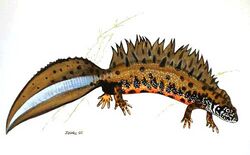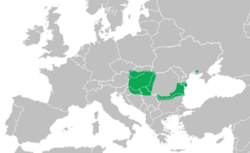Biology:Danube crested newt
| Danube crested newt | |
|---|---|

| |
| Scientific classification | |
| Domain: | Eukaryota |
| Kingdom: | Animalia |
| Phylum: | Chordata |
| Class: | Amphibia |
| Order: | Urodela |
| Family: | Salamandridae |
| Genus: | Triturus |
| Species: | T. dobrogicus
|
| Binomial name | |
| Triturus dobrogicus (Kiritzescu, 1903)
| |

| |
| Synonyms[2] | |
| |
The Danube crested newt or Danube newt (Triturus dobrogicus) is a species of newt found in central and eastern Europe, along the basin of the Danube river and some of its tributaries and in the Dnieper delta. It has a smaller and more slender body than the other crested newts in genus Triturus but like these, males develop a conspicuous jagged seam on back and tail during breeding season.
For half of the year or longer, adults live in slow-flowing river margins, lakes, or ponds, where reproduction takes place. Males perform a courtship display, and females lay around 200 eggs individually onto leaves of aquatic plants. Larvae develop two to four months in the water before reaching metamorphosis. For the remainder of the year, the newts live in shady land habitats, usually forests. Although not yet considered threatened, Danube crested newt populations have declined significantly, the reason being mainly habitat loss. The species is protected by law in the European Union.
Taxonomy
The Danube crested newt was described as a variety of the northern crested newt (Triturus cristatus) by C. Kiritzescu in 1903.[3] Later, it was considered a subspecies until genetic analysis supported its recognition as a separate species in the crested newt species complex.[2] The northern crested newt is its sister species, according to phylogenomic studies.[4][5]
Separated populations from the Danube Delta and the Pannonian Basin (see section Distribution and habitats) were described as two subspecies, T. dobrogicus dobrogicus and T. dobrogicus macrosoma, in 2000.[6] Later genetic study, however, did not support the distinction of these two forms.[7][8]
Description
Measuring 13 to 15 centimetres (5.1 to 5.9 in) long in total, sometimes up to 18 centimetres (7.1 in) in females,[9]:345 the Danube crested newt is the smallest crested newt species. It has a more slender, elongate body than the other species, well adapted to swimming, with a narrow head and relatively short limbs. This body shape has evolved through an increase in the number of rib-bearing vertebrae: there are 16–17 of them in T. dobrogicus, the highest number among the crested newts.[10]:10–14
The Danube crested newt's back and sides are dark brown with black spots and white stippling. The belly is orange to red (in other crested newts, it is usually yellow or orange–yellow), with small or medium-sized black blotches that have sharp edges. Like all crested newts, T. dobrogicus males develop a crest on their back and tail during breeding phase, which can be quite high and jagged, usually starts between the eyes and nostrils, and is interrupted at the tail base. Another feature of males at breeding season is a bluish-white stripe along the tail.[10]:10–14[9]:345 Females can sometimes have a yellow stripe along the back, similar to the Italian crested newt (T. carnifex).[9]:345
Distribution and habitats
The Danube crested newt is found in three allopatric areas of distribution from central to eastern Europe:
- Pannonian basin: From easternmost Austria through Czech Republic (small part in the southeast), Slovakia, Hungary, northern Croatia, Bosnia-Hercegovina (marginally), northern Serbia to the east of Romania and southeast of Ukraine (Transcarpathian region). This includes the middle floodplains of the Danube river and some of its tributaries, including the Drava, Sava and Tisza.[7]
- Lower Danube and Danube delta: Separated from the Pannonian basin by an area where the northern crested newt occurs, this central part ranges from southern Romania, northern Bulgaria, and small parts of southern Moldova to the Odesa region of southern Ukraine.[7]
- Dnieper delta: This small area of distribution in southern Ukraine was reported in 2005. It is now isolated by steppe from the Danube basin, but it has been suggested that these areas were connected through marshlands during the last glacial maximum, when the level of the Black Sea was around 100 metres lower than today. This range may also extend to the lower basins of the Dniester and Bug rivers.[11]

In addition to the northern crested newt to the north, the Danube crested newt's range borders that of the Italian crested newt (T. carnifex) in the west, and that of the Macedonian (T. macedonicus) and Balkan (T. ivanbureschi) crested newts in the south.[10]:16–17
Compared to the other crested newt species, the Danube crested newt is more adapted to life along a river system and frequently occurs in flowing water and together with fish. Typical breeding sites are slow-flowing river margins, oxbow lakes, flooded marshland, larger ponds, or ditches, provided abundant underwater vegetation is available.[10]:44–48[13]:144–145 During land phase, the newts live in deciduous forests or groves, bushlands, or meadows.[1]
Lifecycle and behaviour
Danube crested newts have the longest aquatic phase in the genus Triturus. Adults move to their breeding sites in February or March and usually stay there for six months; occasionally, they may even stay longer or return to the water in autumn.[10]:44[13]:144–145 Males court females with a display of ritualised body movements. When they have gained the female's interest, they guide it over a spermatophore they deposit on the ground, which the female then takes up with her cloaca.[10]:80–89 The eggs are fertilised internally. As in other crested newts, a female lays around 200 eggs per season, which are folded individually into leaves of aquatic plants. Eggs and larvae are smaller than in the other crested newt species, and they take longer (two to four months) until they reach metamorphosis and leave the water.[10]:61–65[9]:345
Both in water and on land, the newts are largely nocturnal. In their aquatic habitats, they hide under vegetation, and on land, they use structures such as logs, rocks, or small animal burrows for cover.[10]:47–48,58 They feed mainly on different invertebrates, but in the water may also prey on tadpoles and smaller newts.[10]:58–59 Predators include herons and other birds, snakes such as the grass snake, and various carnivorous mammals.[10]:78
Threats and conservation
The population of the Danube crested newt has declined significantly, and the International Union for Conservation of Nature has assessed its conservation status as "least concern". The main threat is habitat destruction by humans, especially through drainage, damming, or pollution. Hybridisation with other crested newt species and a loss of breeding ponds because of decreasing spring rain in the southern range (possibly due to global warming) are also seen as threats.[1] Like the other crested newts, T. dobrogicus is listed in the Berne Convention (appendix II) and the EU Habitats Directive (annexes II and IV), and capture, disturbance, killing, trade, and destruction of habitats are prohibited.[14][15]
See also
- List of amphibians of Europe
References
- ↑ 1.0 1.1 1.2 Amphibian Specialist Group (2022). "Triturus dobrogicus". IUCN Red List of Threatened Species 2022: e.T22216A89709283. doi:10.2305/IUCN.UK.2022.RLTS.T22216A89709283.en. https://www.iucnredlist.org/species/22216/89709283. Retrieved 27 July 2022.
- ↑ 2.0 2.1 Frost, D.R. (2015). "Triturus dobrogicus (Kiritzescu, 1903). Amphibian Species of the World: an Online Reference. Version 6.0". New York, USA: American Museum of Natural History. http://research.amnh.org/vz/herpetology/amphibia/index.php//Amphibia/Caudata/Salamandridae/Pleurodelinae/Triturus/Triturus-dobrogicus.
- ↑ Kiritzescu, C. (1903). "Contributions à la faune des batraciens de Roumanie" (in fr). Buletinul Societatii de Sciinte Din Bucuresci, România 12: 243–265.
- ↑ Wielstra, B.; Arntzen, J.W. (2011). "Unraveling the rapid radiation of crested newts (Triturus cristatus superspecies) using complete mitogenomic sequences". BMC Evolutionary Biology 11 (1): 162. doi:10.1186/1471-2148-11-162. ISSN 1471-2148. PMID 21672214.
- ↑ 5.0 5.1 Wielstra, B.; McCartney-Melstad, E.; Arntzen, J.W.; Butlin, R.K.; Shaffer, H.B. (2019). "Phylogenomics of the adaptive radiation of Triturus newts supports gradual ecological niche expansion towards an incrementally aquatic lifestyle". Molecular Phylogenetics and Evolution 133: 120–127. doi:10.1016/j.ympev.2018.12.032. ISSN 1055-7903. PMID 30630099.
- ↑ Litvinchuk, S.N.; Borkin, L.N. (2000). "Intraspecific taxonomy and nomenclature of the Danube crested newt, Triturus dobrogicus". Amphibia-Reptilia 21 (4): 419–430. doi:10.1163/156853800300059313. http://www.caudata.org/forum/attachments/f1173-advanced-newt-salamander-topics/f30-species-genus-family-discussions/f32-eurasian-newts-triturus-former-triturus-calotriton-euproctus/14104d1297113263-t-dobrogicus-macrosomus-courtship-breeding-photos-intraspecific-taxonomy-nomenclature-danube-crested-newt-triturus-dobrogicus.pdf.
- ↑ 7.0 7.1 7.2 Vörös, J.; Arnzten, J.W. (2000). "Weak population structuring in the Danube crested newt, Triturus dobrogicus, inferred from allozymes" (PDF). Amphibia-Reptilia 31 (3): 339–346. doi:10.1163/156853810791769518. https://www.researchgate.net/publication/233574302.
- ↑ Wielstra, B.; Arntzen, J.W.; Vörös, J. (2016). "Is the Danube crested newt Triturus dobrogicus polytypic? A review and new nuclear DNA data". Amphibia-Reptilia 37 (2): 167–177. doi:10.1163/15685381-00003041. ISSN 0173-5373. http://eprints.whiterose.ac.uk/104514/3/Wielstra%20AR%202016.pdf.
- ↑ 9.0 9.1 9.2 9.3 Sparreboom, M. (2014). Salamanders of the Old World: The Salamanders of Europe, Asia and Northern Africa. Zeist, The Netherlands: KNNV Publishing. doi:10.1163/9789004285620. ISBN 9789004285620.
- ↑ 10.0 10.1 10.2 10.3 10.4 10.5 10.6 10.7 10.8 10.9 Jehle, R.; Thiesmeier, B.; Foster, J. (2011). The crested newt. A dwindling pond dweller. Bielefeld, Germany: Laurenti Verlag. ISBN 978-3-933066-44-2.
- ↑ Litvinchuk, S.N. (2005). "A Record of the Danube Newt, Triturus dobrogicus, from the Dnepr River Delta (Ukraine)". Russian Journal of Herpetology 12 (1): 69–72. http://rjh.folium.ru/index.php/rjh/article/view/683.
- ↑ Gollmann, G.; Pintar, M. (2009) (in de). Erhebung des Donaukammmolches (Triturus dobrogicus) in der Lobau [Assessment of the Danube crested newt (Triturus dobrogicus) in the Lobau floodplain] (Report). University of Natural Resources and Applied Life Sciences, Vienna. https://www.wien.gv.at/kontakte/ma22/studien/pdf/donaukammmolch.pdf.
- ↑ 13.0 13.1 Griffiths, R.A. (1996). Newts and salamanders of Europe. London, UK: Poyser. ISBN 0-85661-100-X.
- ↑ "Convention on the Conservation of European Wildlife and Natural Habitats". Bern: Council of Europe. 1979. http://conventions.coe.int/treaty/en/Treaties/Html/104.htm.
- ↑ "Council directive 92/43/EEC on the conservation of natural habitats and of wild fauna and flora". Act No. 1992L0043 of 1 January 2007. http://eur-lex.europa.eu/legal-content/EN/TXT/?uri=CELEX:01992L0043-20070101. Retrieved 2015-05-31.
External links
Wikidata ☰ Q253442 entry
 |



